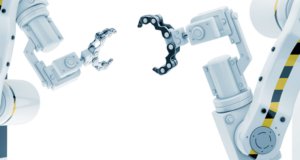Robots: Opening interesting doors
Cobotix leads way in integrating human staff with robots
By Rosa Diaz and Ada Slivinski (Edited from an article published in Sheet Metal Journal, September 3, 2019).
In their early days as a sheet metal fabrication shop, Cobotix Manufacturing in Port Coquitlam saw the waste and inefficiencies common in the industry and pivoted to embrace new technology and production methods, first integrating robots into their process about a year and a half ago. The practice has revolutionized the way they do business.
Cobotix President Ron Adolf says integrating robotics helps the company retain staff because it allows them to do the more interesting, complex work instead of the risky, repetitive tasks they were charged with previously.
“A job that could be carpal-tunnel inducing, that’s repetitive, boring, or has any element of risk, a robot could do that,” says Adolf.
“We’re not replacing people; we’re giving better tools to our team. More interesting work turns into better pay. And because of the efficiencies of automation, it allows our pay scale to go up as well,” said Adolf.
The benefits extend beyond the company to the workers. When salaries, wages and bonuses go up as well as new initiatives like profit sharing, that’s when companies can start to see buy-in from their team. “If companies don’t do that [share the benefits of automation], their employees actually try to sabotage it,” he said.
Much of the work of integration and on-the-ground implementation has been done by machine shop lead Marc Saunter, who spends part of every day programming, running through, and building on movement sequences for robots.
“We’ve actually integrated a sequence with robots so that until he removes his arm, it will not come down,” he said.
For training, often the approach Cobotix will use is to have a robot working near a machine using traditional fabrication methods. By slowly starting to interact with the robot, staff grow more comfortable and familiar with how it works. They also lean on training videos provided by companies like Amada and Trumpf as well as the assistance of a safety advisor from the Manufacturing Safety Alliance of BC.
“The Alliance knows all the regulations and standards, and you’re not afraid to open up. It’s non-intimidating,” said Saunter.
“It feels like we have a partner, a safety team. It gives us far more confidence in developing our safety program and feels like we have someone really strong in our corner.”
A job that could be carpal-tunnel inducing, that’s repetitive, boring, or has any element of risk, a robot could do that.
Not only does automation speed up and add efficiencies to the manufacturing process, there is also a significant safety benefit. “You cannot put a price on it,” said Adolf, “People cannot be injured anymore,” at least not in the same ways. “Having someone standing in front of the machine doing he same thing over and over again, there’s a safety issue. Some equipment cannot accommodate it because there’s no light curtain for example, and the human being can be exposed to some injury, so we have robots use it,” said Kurilyak.
“Robots never get tired, do exactly the same operation for three to five years every day, 365 days a year, with no break. They work overnight. Set things up on Friday and come in Monday morning, and there’s a stack of parts,” said Cobotix President Ron Adolf.
It feels like we have a partner, a safety team.
For a sheet metal fabricator where time of the essence, this means they can increase output and profits.
“That product was never ever touched by a human being. Robots even hook it up to the paint skid. The cost of one product dropped from $10 to $3.90, and Cobotix makes more money on each one,” said Cobotix COO Alex Kurilyak.
Co-locating production in the customer’s facility eliminates many transportation and logistics costs.
Recently, Cobotix has set up a facility in house at Fluxwerx Illumination, a commercial lighting company in Surrey— another example of how the company innovates and stays ahead of the times.
Co-locating production in the customer’s facility eliminates many transportation and logistics costs, saving about $150,000 to $200,000 per year.
A symbiotic relationship, it is a shift from the traditional vendor/supplier relationship that can be fraught with a lot of waste and inefficiencies.
“We do not actually just give them what they want, we’re ahead of them. They can’t keep up with us, and that company is rapidly growing,” said Kurilyak.
The company’s three-year plan is to have cells in Seattle, Southern California, Texas, and Atlanta, Georgia. In British Columbia, they plan to grow from two facilities to five.
“We grow together, we win together… and that’s a much more interesting place to be,” said Adolf.



